Introduction: Tutorial of a Powering Solution for an Arduino Controlled Robot Car (RC)
In this tutorial you will be shown a simple way to power an arduino controlled RC. That means actually a practical way to power separately an arduino and the accompanying motor shield (which powers the motors).
In case that someone wants to avoid using a LiPo but use normal, easy to find (in every super market) batteries instead, a reliable solution according to my experience is to use 6AAA batteries to power arduino and 4AA batteries to power the motor shield.
At least I haven't found a ready to use solution in the market that has this implementation and also to be controlled from a toggle switch.
You are only a few steps away from learning how to build the pictured above circuit.
The DC power plug goes to arduino (brings 9V) and the free ending wires (one red and one black) go to the motor shield (bring 6V).
You could use other battery cases to have the voltages you want available!
Step 1: Materials and Tools
Materials
1. Case for 6 X AAA batteries
2. Case for 4 X AA battteries
3. DC power plug 2.1mm
4. 2 pieces of 10 cm long cable (the red ones in the picture)
5. 4 pieces 1 cm long of heat shrinks
6. 1 toggle switch for controlling two circuits separately
7. Soldering material
8. Insulation tape
Tools
1. Soldering iron
2. Desolder sucker
3. Third hand tool
4. Wire stripper or something relevant
5. Wire cutter
6. Plier
Step 2: Securing the Toggle Switch With a Third Hand Tool
This is only a simple way to prepare all cables to be ready for soldering.
Slip the two red cables from the cases through two heat shrinks and then connect the free ending of them to the toggle switch.
Step 3: Toggle Switch Prepared for Soldering
The upper two red cables (as seen in the photo) are actually the positive output of the 6XAAA battery case. This positive output is interrupted by the switch.
The lower two red cables (as seen in the lower part of the photo) are the positive output of the 4XAA battery case.
Of course is our choice to pass the positive or negative output of any battery case through the switch and that has no role to the outcome.
Step 4: Toggle Switch Ready for Heat Shrink
This step has the meaning of a detailed and neat job. No little wire leftover would create any peculiar troubles after this. All of the wires are well covered in switch connections with heat shrinks.
Step 5: Ready to Use Toggle Switch
This is how the toggle switch looks like after..everything!
The two black wires with the free ending are the negative outputs of the battery cases.
Step 6: Preparing Cables That Are Going to Power Arduino
The cables from the 6XAAA battery case are going to be connected to the DC power plug.
First, pass the cables through the black insulating exterior part of the plug.
Step 7: Cable Connection to the Plug
The red (positive end of batteries) cable should be fastened to the inner conductive part of the plug (as seen).
The black (negative end of batteries) cable should be fastened to the outer conductive part of the plug.
They should be fastened well enough to secure an easy soldering!
Step 8: Solder, Insulate One Cable, Construct Plug
As seen in the photos, after soldering the cables, at least one of them, is wise to be insulated and after screwing the insulated black exterior of the plug, the plug is ready to use.




